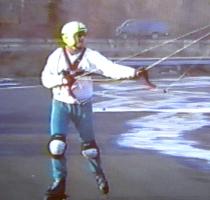Snowkiting Tips
Kiteboarding Tips
Tip #16 – Snowkiting
December was crazy with all the snow and then the huge meltdown. It's great to see the snow back and the lakes frozen.
My first tip for snowkiting is to go out and try it. It is super easy compared to water kiting and just a great way to love the winter.
The above video is from the early 90's (that's the 1990's – over 20 years ago). My good friend and world famous kite flyer Lee Sedgwick is showing us the first stages of snow kiting. Check out the kites he is using – old Quadrafoils – but they're still getting the job done.
Lee also helped pioneer using roller blades, large stacks of kites, buggies and anything else you can think of when it comes to kite flying. You can thank people like him for having the materials needed for kiteboarding developed prior to the invention of kiteboarding as we know it today.
Looking to jump on the snowkiting bandwagon?
1) Beg, borrow or buy a trainer kite. (Many on sale!) Head to your local field or frozen lake and start flying. Already kiteboarding? Grab your kiteboarding kite instead – start in a bit lighter wind than your normal kiteboarding power. Be very careful if you are using a C kite – winter is gusty.
2) Fly, fly, fly – Spend 6-10 hours with just your kite; if you can fly a power stroke with your eyes closed, you are ready to grab a board or skis and get going.
3) Grab your skis or snowboard, your helmet (a MUST) and get going. Start nice and slow and remember not to go directly downwind. Try going on a gentle downwind tack.
4) Be patient for the first day or two. Things will gel together within about 4-8 hours of riding and then you will be flying across the snow.
Basic Tips:
- Trainer kites – Less than 80 lbs, use a 2 meter or smaller. Less than 150 lbs, use a 2.5 - 3.0 meter kite. More than 150 lbs, use a 3 - 5 meter kite.
- Hard pack snow – Use a kiteboarding kite 3 - 5 meters smaller than you would for water.
- In powder you will need a kite comparable to water riding, maybe a bit smaller since the winter air is denser and generates more power.
- Glare Ice – Use ice skates, small kites, and full padding. The guys in Minnesota go 50+ mph.
- Load your gear on a plastic sled – Makes for easy transportation to and from the flying area.
- Bring along plastic bags full of sand or some dumbbells for weight on your kite. Sometimes you just can't pile up enough snow.
- Dress in layers – You will be hot in no time.
- Don't try to launch in the wind shadow of trees – The middle of a lake is almost always more consistent and windier. A 70-foot tree casts about a 500 foot long wind shadow.
